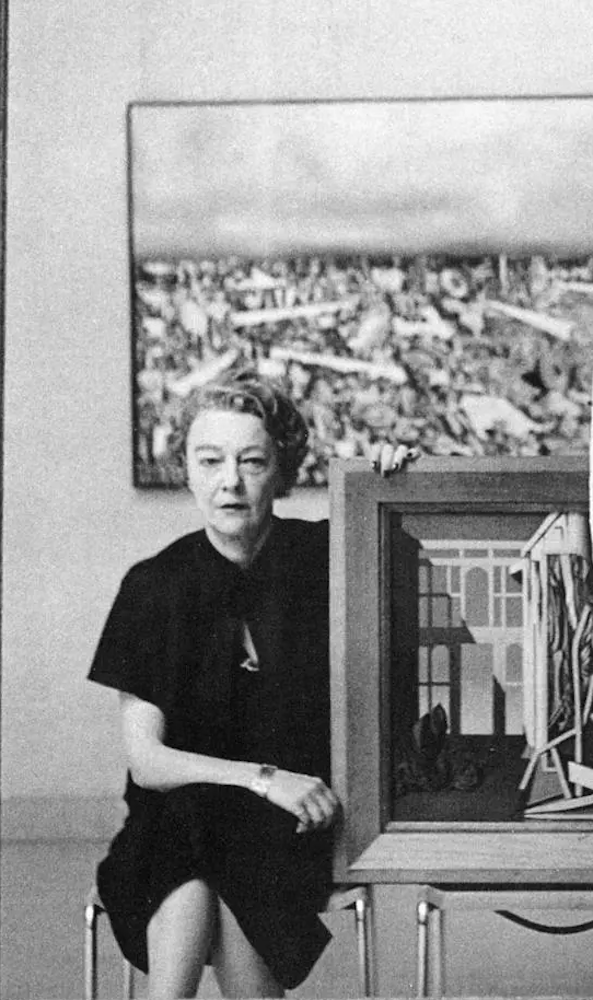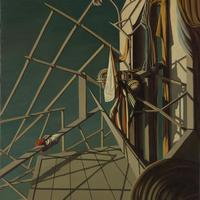More about Kay Sage
Works by Kay Sage

Contributor
Kay Sage may not have been the most friendly artist in the Surrealist movement but she was probably the saddest.
Kay Sage was born in 1898 in a town just outside of Albany, New York. Her mother was a bit of a nutcase and after having two children decided that the whole having a family thing wasn’t for her. Her solution was to take Kay and set off for Europe, leaving behind her older daughter and her husband, who continued to support the two for years after their departure. Kay and her mother settled in Italy, but bounced around Europe. Sage was enrolled in many different schools during this time, reportedly never spending more than three years at any one. Though this was probably hard on her socially, it did mean that she became proficient in French, Italian, Spanish, and Portuguese in addition to her native English. Though she had been painting on her own for many years, her first official art classes started in 1919 at the Corcoran School of Art in Washington D.C.. After this, she decided to focus on art completely and moved to Rome, taking classes at the British School and the Free School of Fine Arts from 1920-25.
It all went downhill when she met and married Prince Ranieri di San Faustino. He was a prince which was cool, but he was also the worst influence on her art, in that she hardly made any during the ten years that she was married to him. Eventually she found her way back to art, which unfortunately resulted in their divorce. After her divorce, Kay moved to Paris where her artistic life really began.
She began exhibiting her work at the Salon des Surindépendants in Paris, where André Breton and Yves Tanguy loved her work so much that they assumed it was done by a man, apparently a high compliment for women at the time. Breton never got over the fact that Sage was a woman and therefore never fully accepted her into the Surrealist movement. Tanguy, on the other hand, was more than ok with it. He and Sage began a romantic relationship that lasted the rest of their lives. They influenced each others work, but insisted on the fact that they were two individuals rather than a team. And individuals they were. People referred to Sage as “imperious, forbidding, moody, quick to anger, remote, private, solitary, aloof, contradictory, and unapproachable,” while Tanguy was friendlier, but had a knack for headbutting people while he was drunk. But alas, they were in love. All was well until a stroke claimed Tanguy’s life in 1955, leaving Sage in a severe depression. She also got cataracts during this time that worsened her sight and her ability to paint greatly. After a botched eye surgery left her almost blind, Sage just didn’t see the point anymore and shot herself in the heart. Her suicide note read, “The first painting by Yves that I saw, before I knew him, was called ‘I’m Waiting for You.’ I’ve come. Now he’s waiting for me again — I’m on my way.” A beautiful and incredibly heart-wrenching sentiment.
Sources
- Blumberg, Naomi, and Sonia Chakrabarty. "Kay Sage | American Painter And Poet." Encyclopedia Britannica. Web. 2 Apr. 2018.
- Rosenberg, Karen. "‘Double Solitaire,’ Art By Kay Sage And Yves Tanguy - Review." Nytimes.com. N.p., 2011. Web. 2 Apr. 2018.
- Suther, Judith D. A House of Her Own: Kay Sage, Solitary Surrealist. Lincoln: University of Nebraska Press, 1997, p.1
Featured Content
Here is what Wikipedia says about Kay Sage
Katherine Linn Sage (June 25, 1898 – January 8, 1963), usually known as Kay Sage, was an American Surrealist artist and poet active between 1936 and 1963. A member of the Golden Age and post-war periods of Surrealism, she is mostly recognized for her artistic works, which typically contain themes of an architectural nature.
Through her marriage to an Italian prince, she became princess of San Faustino in 1925. She was also the sister-in-law of Donna Virginia Bourbon del Monte, wife of industrialist Edoardo Agnelli of the Agnelli family.
Check out the full Wikipedia article about Kay Sage












"Breton never got over the fact that Sage was a woman and therefore never fully accepted her into the Surrealist movement." This statement is barefaced nonsense. Not only did Breton publicly praise Sage, but she was included in Surrealist exhibitions. Further, the statement that Breton did not accept women artists as full-fledged Surrealists is also nonsense. I am not going to do Ms. Browne's research for her (although perhaps I should, since she seems disinclined to do intelligent, or even competent, research herself, other than regurgitating Wikipedia), but the large number of women Surrealists, from Dorothea Tanning to Toyen, is a matter of historical record.